Application Analysis of Low-power Wiring Crimp Contacts Terminals
With the rapid development of new energy vehicles, the application of low-power wire crimp contacts terminals is becoming more and more extensive. The low-power wiring harness is composed of wires connecting various parts of the automotive electrical system. And the ends of the wiring harness are connected to various sensors, meters, relays, and switches through connectors (terminals). The main function of the low-power wire harness crimp contacts is to fix the conductive part of the wire with the connector and ensure the firmness and stability of the connection. This article will introduce the application of low-power wiring harness crimp contacts terminals for new energy vehicles.
Types of Low-power Crimp Contacts
There are many types of low-power crimp contacts. Such as pin contacts, interface contacts, clamping contacts, flat contact, socket contacts, etc. The exact use of each contacts pins depends on the electrical part being connected.
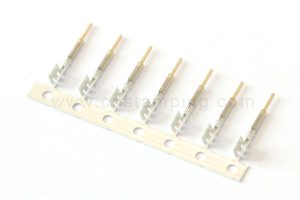
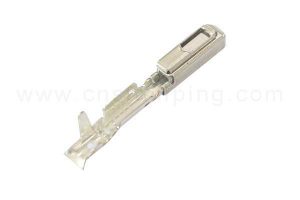
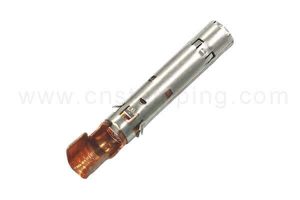

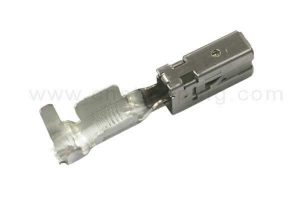
The Role of Low-power Wire Crimp Terminals
The main function of the low-power wire crimp terminal pins is to realize the fixation of the connecting wire and the terminal. And ensure the stability and reliability of the connection. When wires within the harness are moved or switched, the terminals automatically adjust to maintain a stable connection and prevent connections from loosening or falling out. In addition, low-power harness crimp contact pins protect the separated ends of wires from damage or aging.
In fact, New energy vehicle low-power wiring crimp terminal contacts are widely used, mainly in the following aspects:
Battery Terminals
The power battery of a new energy vehicle is a very important component, so the connection of the battery must be very strong. This requires the use of clamp-on battery terminals. It ensures that the connection between the positive and negative terminals of the battery remains intact, avoiding malfunctions during discharge and charging.
Drive and Transmission Terminals
Drives and transmissions in electric vehicles are critical parts of the electric motor. Therefore, high-quality pin-type and interface-type terminals must be used to ensure effective connectivity and good wear resistance.
Electric Control Box Terminals
The electric control box is a device used to control the operation of the motor. In this installation, it is necessary to use high-end interface-type terminals and clamp-type terminals to ensure that all connections are secure. This can improve the reliability and performance stability of the electronic control system.
Sensor Terminals
The sensor connection of new energy vehicles can use flat or socket crimp contacts. These connectors ensure that the sensor can transmit signal to the electronic controller and remains in good contact.
Low-power wire crimp terminals play a vital role in new energy vehicles. Choosing the right terminal can ensure the reliability and performance stability of the electrical system. With the further development of new energy vehicles, people will continuous optimize low-power wire crimp terminals to adapt to more complex application scenarios.
Application of Low-power Crimp Contacts Terminals
Low-power wire crimp terminals play an important role in automotives, and the application scenarios include the following aspects:
- Battery management system
The battery management system is vital to new energy vehicles. The low-power harness terminal connects every battery in the box to ensure normal communication and data transmission between batteries.
- Electric vehicle controller:
The electric vehicle controller is an important device to control the rotation of the motor in new energy vehicles. The low-power automotive terminals connect various circuits in the controller to ensure normal communication and signal transmission between the circuits.
- Charging pile
The low-power wiring harness terminal is also used in the charging pile of new energy vehicles to connect the charging control, display screen, and other circuit equipment.
- Interior electronic equipment
In new energy vehicles, such as navigators, stereos, on board computers, etc., also require low-powerwiring harness terminals for connection and communication.
- Body control system
The body control system of new energy vehicles also requires the application of low-power crimp terminals to connect door locks, window controls, seat adjustments, and other equipment.
In one words, The low-power stamping terminals plays an irreplaceable role in the car’s electrical system. And they can ensure the normal connection and data transmission between various electronic devices.
In Conclusion
With the advent of the new energy era, only the continuous exploration of the manufacturing technology of parts can satisfy the rapid iteration of new functions. Connector terminals will be smaller in size, higher in precision, and stronger in current carrying capacity in the future. And their terminal structures will also undergo new technological changes and developments. Only terminal manufacturers with high adaptability and strong manufacturing capabilities can be selected. It can better meet the actual needs of the car!
Heju Stamping-OEM Crimp Contacts Terminals Manufacturer-Models Complete&Flexible Delivery 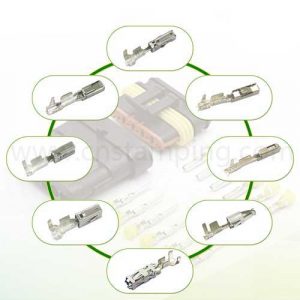
Dongguan Heju Precision Electronic Technology Co., Ltd. is a precision stamping manufacturer specializing in producing and designing automotive stamping terminals. It has passed the three major certification systems of ISO9001, ISO14001, and IATF16949. It has many years of experience in connector terminals, auto crimp terminals design and development. The thermal conductivity and electrical conductivity of the terminal are stable. Besides, We can meet the quality standards of imported brands and actively cooperate with customer product needs for customization to achieve localization substitution. Please feel free to contact us for your stamping project.
